
by admin | Dec 4, 2013 | Cajun Country, Greater New Orleans, North Louisiana, River Road
With Thanksgiving behind us and the tree ready for decorating in our front room, I can officially say we’re full swing into the holiday spirit. This is the time of year I make my wish list of must-hit events and prepare the kids for running full steam ahead until Christmas.
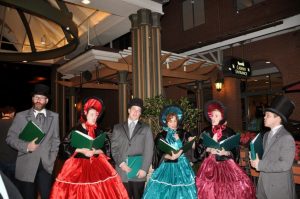 |
| Caroling at Miracle on Fulton Street |
We start with the tried and true ones, from Celebration in the Oaks at City Park to Santa, real reindeer and fake “snow” at the Miracle on Fulton Street. Then there’s the winter wonderland created in the lobby of the Roosevelt Hotel and the evening out sans children for a special Reveillon dinner.
We also try to mix in a few new experiences to brighten the holidays. Last year, we tried a children’s rendition of the Nutcracker at Loyola University and a staging of A Christmas Carol at the Contemporary Arts Center. For New Year’s, we ventured north to Natchitoches to experience the Christmas Festival of Lights, well worth the trip for anyone thinking of visiting this beautiful, historic town.
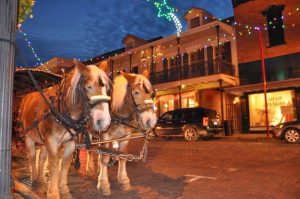 |
| Natchitoches’ Christmas Festival of Lights |
This year, I’ve been eyeing the Moscow Ballet’s Great Russian Nutcracker at the New Orleans Saenger. Perhaps we’ll set off out of town again to experience what the rest of the state has to offer. This weekend, the small town of Arnaudville pulls together some of the region’s best artists for Fire and Water: Le Feu et l’Eau Rural Arts Celebration.
It’s also the time for holiday bonfires, which, believe it or not, we have never seen! Oak Alley hosts their 38th Annual Christmas Bonfire Party this Saturday, Dec. 7. The 24th Annual Festival of the Bonfires lights up next weekend in Lutcher, offering a glimpse into the much-anticipated Christmas Eve bonfire spectacular in Gramercy and Lutcher.
With so much going on, it’s hard to decide where to even begin. Perhaps start with my article in Country Roads on ways for “Lighting the Dark” this holiday season or check out their Calendar of Events for endless possibilities. Maybe we’ll see you around town as you discover the joy of winter in Louisiana.
 |
| Mr. Bingle at Celebration in the Oaks |

by admin | May 15, 2013 | Cajun Country, Most popular
On one of the last cool weekends before summer, we jumped in the car to visit Avery Island, home to Tabasco as well as the beautiful oasis, Jungle Gardens. On previous trips, we always took I-10 from New Orleans to Breaux Bridge and then headed south. This time, however, we made our way along the southern route, traveling Highway 90 through Morgan City, Patterson and Franklin before reaching our destination.
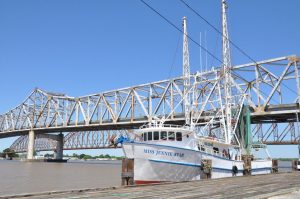 |
| Atchafalaya River as seen from Morgan City |
The drive brought us through scenic vistas of classic Louisiana swamps. While the kids watched “Ice Age” in the back of the car, we immersed ourselves in the abundant cypress trees basking in the dark waters prolific in this part of the state. Our first destination was Morgan City, sporting a slogan “Right in the Middle of Everywhere” and famous for its annual Shrimp and Petroleum Festival (the name says it all). On a map, Morgan City makes up half of an island surrounded by countless lakes, rivers, bayous and various other bodies of water twisting and turning around the floating land.
 |
| Southwest Reef Lighthouse |
We headed straight for the historic downtown toward Front Street and the towering floodwall protecting the city from the Atchafalaya River. The road led us to an opening in the floodwall, and we parked at the edge of the river beside a handful of people fishing. The kids were elated to finally stretch their legs and set off at a sprint along the dock. We raced behind, taking in the muddy river and the boats tied up at its side. Before long, we ascended the stairs to the floodwall and looked down at the city below. Traffic was light on this Saturday morning, yet shops appeared to be opening in the historic buildings.
The floodwall gave us a great view of the river, and the three bridges spanning across it–one for trains and the other two for cars. One of them, the Long-Allen Bridge, boasted a pier resting on one of the deepest foundations in the world (176 feet below low water stage) when it was built in 1933. Across the river, a bright red lighthouse stared back at us. Known as Southwest Reef, the lighthouse was built in 1858 and relocated in 1987 from the Atchafalaya Bay to a park in Berwick.
 |
| Wedell-Williams Aviation and Cypress Sawmill Museum |
After our walk, we drove the streets admiring the buildings, churches and parks. It was a brief stay, though, as we had several other destinations for the day including the Louisiana State Museum in Patterson. The Wedell-Williams Aviation and Cypress Sawmill Museum showcases two very different occupations that were both integral to this small town.
On one side of the museum, brightly colored airplanes are scattered about both the floor and ceiling. In 1928, pilot Jimmie Wedell and oilman and timber baron Harry Williams joined forces to design aircrafts in Patterson that were faster than the competition. At the announcement of the movie, we all grabbed a seat and waited for the multiple screens to lower across the room. The kids were wide-eyed as planes raced from screen to screen and simulated wind blew in our faces. Wedell and Williams were daredevils of their time who used their fearless talents to revolutionize the aviation industry.
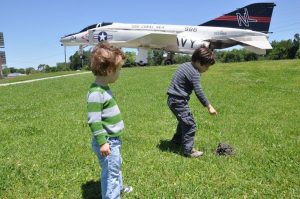 |
| The fascinating crawfish home in front of the museum |
Across the lobby, the cypress sawmill museum tells the industry’s story through pictures, giant logs and, if possible, even larger saws. Louisiana played a critical role in the country’s logging industry, and at one time, Patterson was home to the largest sawmill in the world. It was both amazing and eye-opening, and exactly the right size for the attention spans of our kiddos. We had just wrapped up our tour when they scooted out the front door to investigate the crawfish homes on the front lawn, oblivious to the jet mounted just above their heads.
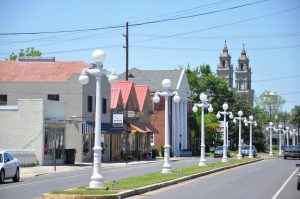 |
| Franklin’s Historic District |
Down the road in Franklin, we took a whirlwind tour of the downtown, which boasts over 400 historic structures. I have to say I have never seen so many historic signs all standing in one place. We immensely enjoyed the scenic main street, filled with shops and picturesque light poles. Spanning out on either side were pristine white mansions, shrouded in a canopy of moss-covered live oaks. One block away, the much-talked-about Bayou Teche flows past the homes, adding to the laid back, Southern feel already emanating from the town.
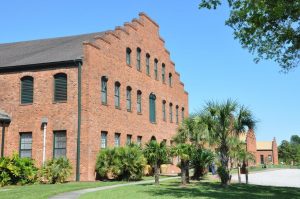 |
| Tabasco Factory at Avery Island |
It was nearly 3 o’clock by the time we arrived at Avery Island, paying our dollar toll to cross the bridge to enter Tabasco territory. Home to the McIlhenny hot sauce empire, Avery Island sits on one of five salt domes found in this part of Louisiana. They say that the salt here is “as deep as Mount Everest is tall,” a mind boggling thought. The factory was closed the day we visited, but we were still able to tour the facility that strongly smelled of the spicy sauce. The kids were thrilled when the tour guide gave them samples of miniature Tabasco bottles, which have now taken a spot of fame in their own collections at home.
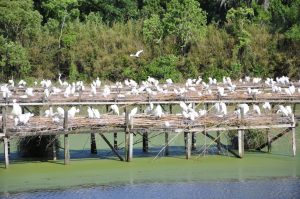 |
| Snowy Egrets at Jungle Gardens |
Aside from Tabasco, Avery Island is home to the wild and beautiful Jungle Gardens. A driving tour through the 170-acre gardens brought us past alligator-filled ponds, an 800-year-old Buddha and countless live oaks, azaleas, camellias and bamboo. Thankfully, the unseasonably cool weather kept the mosquitoes at bay so we could enjoy exploring every inch of the property. It was also the perfect time of year for the nesting snowy egrets, which came in droves to the elevated platforms known as “Bird City.”
 |
| Bayou Teche National Wildlife Refuge |
All in all, it was probably one of our most successful adventures already, but we added one final stop to complete the tour. On the return drive, we veered off south of Centerville to enter the Bayou Teche National Wildlife Refuge, established in part to protect Louisiana’s black bear population. While we weren’t looking for bears, we were intrigued by the Garden City boardwalk trail, which we never would have found without this map. We parked by the levee and walked the short distance to an even shorter boardwalk through the swamp. The water underneath was eerily still, clogged with vegetation in this thriving forest; yet the trees overhead were alive with songbirds, each twilling a different tune and flitting about from branch to branch in a blur of colors. We paused a moment to admire them all before climbing back in the car for the return trip home.
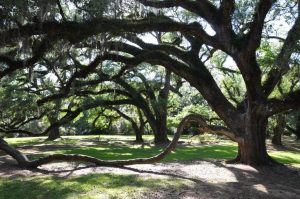 |
| Live oaks at Avery Island’s Jungle Gardens |
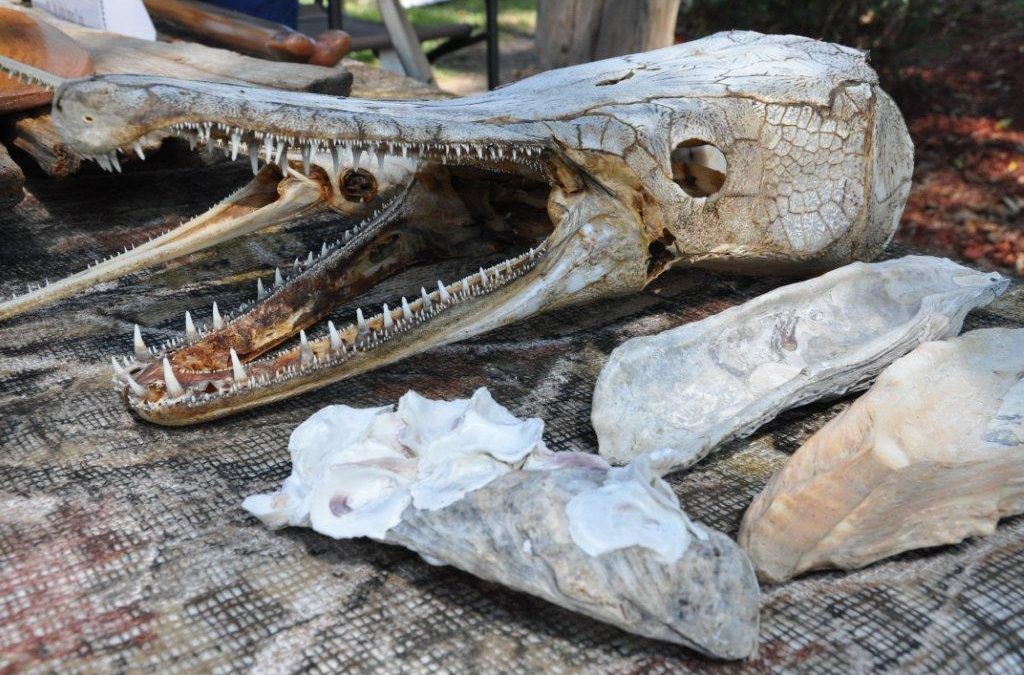
by admin | Oct 9, 2012 | Cajun Country
More times than I can count, we’ve driven the I-10 between Baton Rouge and Lafayette as a straight-shot, watching the Atchafalaya swamps through our windshield tour. This weekend, though, we ventured off the Grosse Tete exit for what I thought was a small swamp exhibit at the Visitor’s Center. Instead, we discovered an amazing gem of a festival, with more free food and live music than we could ever imagine.
.JPG) |
| Live music at the Iberville Swamp Life Expo |
 |
| Animals on display at the Iberville Swamp Life Expo |
We knew something was up when every road in the small town was lined with parked cars. The sounds of Cajun music filled the air as we walked the short distance from our car to the Iberville Swamp Life Expo. Shaded by live oaks and set alongside the peaceful Bayou Grosse Tete, the bustling event was in sharp contrast to the tranquil scenery.
A path of booths circled the property, and we began by browsing the largely functional art on display. Talented John James Clark’s rare display of hand-carved cypress boats looked too pristine for actual use, and artist Charlene Hebert’s oil paintings depicted life in the Atchafalaya. Naturally, the kids were drawn to animal skins and turtle shells on display, and my youngest even set up residence in an exhibitor’s folding chair – determined to just sit and people watch.
.JPG) |
| A big pot of jambalaya at the Expo |
And then came the food. We started off slow, with a piece of bread dipped in the wild flavor of homemade cane syrup. As we rounded the corner, I discovered the Cajun-made Bread Pudding and couldn’t resist its perfect consistency. I kept telling myself, “Life is short, so eat dessert first.” The next half hour was a whirlwind of Crawfish Etouffee d’Atchafalaya, Big Cajun Wild Duck and Andouille Gumbo, Big Pete’s Cajun Cracklins and Bayou Land Mustard Greens and Pig Tails.
We were all walking a bit slower when my four-year-old, Charles, spotted a whole alligator being carved up before our eyes. The still-warm meat melted in our mouths, and Charles was thrilled to shovel it in while boasting to anyone who would listen that he was a “carnivore.” The cooks must have been won over by him because they sent us home with a pair of alligator feet (skin still on), which my husband strategically “forgot” in a friend’s freezer.
.JPG) |
| Plantation in northern Iberville Parish |
After watching the crowd dance to the music for a bit, we continued on our journey, heading north toward Rosedale and Maringouin on a driving tour of historic homes. The Parish website offers a downloadable map marking the locations of several privately owned, but still exquisite plantations. We made the loop up 76 and down 77, passing fields of sugar cane and green pastures all lying on the outskirts of the Atchafalaya Basin levee.
It was a nice reprieve before jumping back on the interstate and soaring past this area’s untamed wilderness. Although we researched hikes in the Atchafalaya, particularly in the Sherburne Wildlife Management Area, the notice of hunting season made us shy away, and the kids were still too small for a canoe trip. Determined though to introduce them to the region, we opted for the next best choice, stopping at the University of Louisiana at Lafayette’s cypress swamp.
.JPG) |
| Resident of the cypress swamp at ULL |
Hidden behind a campus of buildings, the surprisingly large swamp presented more than we bargained for. Initially thrilled to spot a baby alligator among the abundant frogs and turtles, we became slightly nervous as a line of much larger alligators started following our movements around the lake. By the time we circled the entire area, we had seen more than a half dozen of the powerful animals. At one point, a student studying dropped his paper in the water, and I cringed as he reached over and lifted it out, half expecting a gator to get there first.
It was quite the experience, and of course, the kids were beyond excited by our day’s adventures. We finished strong with boudin grilled cheese sandwiches from Johnson’s Boucaniere in downtown Lafayette, before announcing that our diets started Monday.
 |
| Johnson’s Boucaniere in downtown Lafayette |

by admin | Jul 10, 2012 | Cajun Country
The name “Rip Van Winkle Gardens” stuck in my head from the first time I heard it. It’s been on our to-do list for ages, and our recent visit proved the place to be as memorable as its name.
 |
| Joseph Jefferson Mansion |
We made a weekend of the trip, not missing a chance to spend a Friday night with our friend in Baton Rouge. Of course, we made the obligatory visit to Mike the Tiger and brought our picnic dinner to the hill-top tables at the Manship School of Mass Communication. Then we tucked the kids in for the night, ready for their road-trip adventure the next morning.
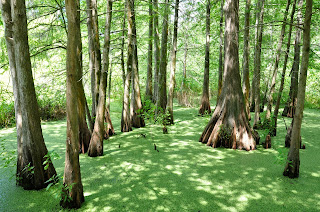 |
| Cypress Island Preserve at Lake Martin |
Every time I cross the Baton Rouge bridge over the Mississippi River and begin heading west, I’m reminded of larger trips we’ve taken to the desert Southwest and beyond. Particularly the drive through Henderson Swamp and its scattered, water-logged cypress trees puts me in vacation mindset.
We didn’t quite make it to Lafayette, but instead veered south through Breaux Bridge and, as on a previous trip, stopped at Lake Martin for a stroll along the Nature Conservancy’s Cypress Island Preserve boardwalk. This time we were in for a double treat. Not only was the visitor’s center open, but the nesting birds were out in full force. We escaped the oppressive heat inside the quaint visitor’s center, where the kids poked and prodded the touchable animal shells and skins on display and we visited with the two helpful staff.
 |
| St. Martinville |
Back outside, we sweated our way along the boardwalk, still managing to enjoy the scenery, before hopping in the car to drive the lake’s east side. This proved to be the best viewing spot for the thousands of egrets and herons flying around the trees. Flashes of pink signaled the presence of roseate spoonbills in the area as well.
From Lake Martin, we again dined at La Petite Paris Cafe in St. Martinville, where the waitress remembered us from our last rowdy, lunchtime visit. (I thought I saw fear in her eyes when we walked through the doors!) We relived our walk down to the Evangeline Oak on the banks of the Bayou Teche, and then set off on our final stretch of road to Jefferson Island.
We traveled the back roads through miles of Louisiana countryside to reach our destination. The land rises as you approach the gardens through a line of live oak trees. Like nearby Avery Island (of the Tabasco fame), Jefferson Island is one of five coastal salt domes emerging upwards of 100 feet above sea level. In 1870, Actor Joseph Jefferson built his mansion on top of one dome and spent 36 winters in his home alongside expansive Lake Peigneur. Future owner J. Lyle Bayless, Jr., surrounded the house with acres of gardens in the 1950s, naming them in honor of the actor who was best-known for his portrayal of Rip Van Winkle.
 |
| Rip Van Winkle Gardens |
Today, the house and gardens are open to the public, and the property also offers a visitor’s center/gift shop, conference center, cafe and a bed and breakfast. The location is a picturesque backdrop for weddings, but we came to explore the trees, plants and bugs that make up the fairytale gardens.
Snaking out from behind the gift shop, the path branched off into a series of options. A peacock strutted by us, while a massive cat eyed us suspiciously from atop a statue. We took the high ground, skirting a Japanese Teahouse and desperately trying to catch a dragonfly at the garden pond. A plaque underneath one live oak tree marked the spot where Pirate Jean Lafitte’s treasure was found. We had to wonder whether this was true…
 |
| Joseph Jefferson Mansion |
The house itself is a four-story, elegant mansion gazing down at the flowing green lawn below. Cottages behind the home beckoned as a bed and breakfast where overnight visitors could awaken to the crowing of the nearby rooster. Completing the circle, we found our way back to the visitor’s center with Lake Peigneur off to our right. Water skiers bounced across the serene waters that hid a tragic history. In 1980, a drilling rig struck a salt cavern, and a hole opened in the lake that turned into a tumultous waterfall draining the water and sucking in 65 acres of the gardens. The theater shows live video taken of the event.
It was a successful adventure for us, particularly as our four-year-old left with a bug catcher of tadpoles. On the ride home, he entertained us with stories of the frogs that would soon live in our house as his younger brother snoozed loudly beside him.
 |
| Garden Statues |
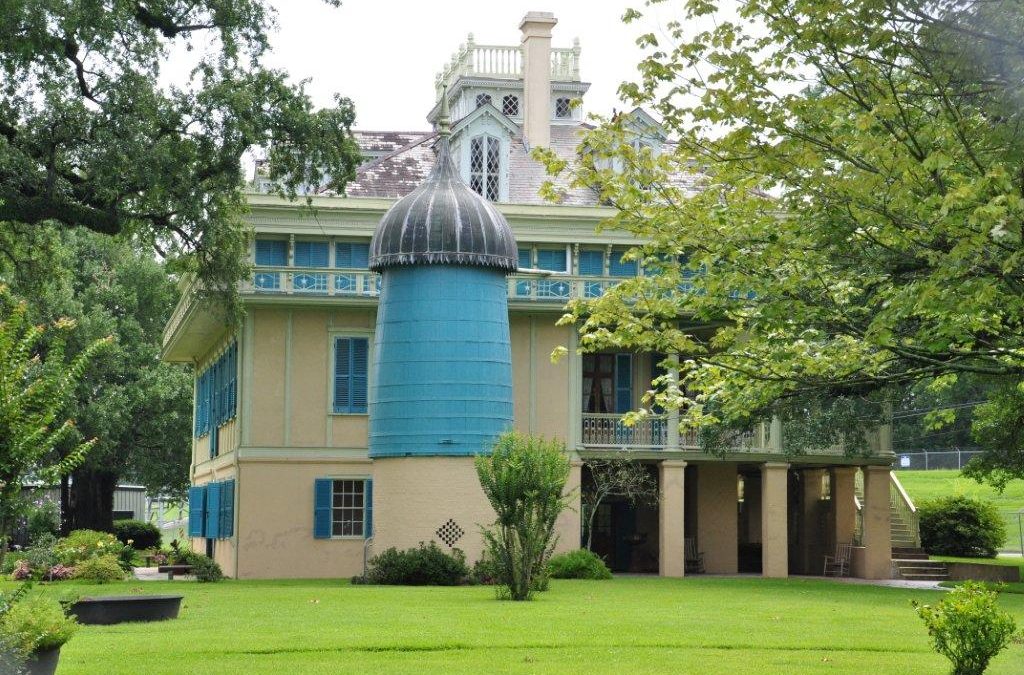
by admin | Jun 19, 2012 | Cajun Country, River Road
We recently took to the road and set off on a decent hour (give or take) drive to Thibodaux. I came prepared with snacks, drinks and a movie for the allotted time, and the trip would have been perfect except for one small flaw. The Hale Boggs Bridge crossing the Mississippi River was closed. How we missed this crucial piece of information was beyond me, but here we were, stuck with a last minute decision to go downriver to the Huey P. Long Bridge or upriver toward the Veterans Memorial Bridge.
Much to our children’s chagrin, we chose the scenic River Road route upriver to Gramercy. It brought back memories of the road trips we took when we younger, fresh out of college, sans children and with lots of time to wander freely. Unfortunately, children scoff at nostalgia. But we made the most of it and discovered parts of the state we’d never seen before, and as with all memories, I’m sure to only remember the good parts of the trip!
The detour began with a sudden stop at the stunning St. Charles Borromeo Catholic Church. Although not open, the expansive grounds and beautiful church and school begged to be photographed–if only it wasn’t raining. For years, the “Little Red Church” was a welcome sight to steamboat captains traveling the Mississippi River to New Orleans, alerting them to the end of their journey.
 |
| Bonnet Carre Spillway |
Only a bit farther up the road, we encountered the first of several plantations we would see on this trip. Ormond Plantation, built around 1790, is brilliantly restored and open for tours detailing its storied past.
River Road takes a sharp right turn at the Bonnet Carre Spillway, a location made famous by the floodgates opened here whenever the Mississippi River comes dangerously close to topping its levees. I’d seen it on TV and in pictures hundreds of times, but never in person. The photos don’t do justice to the vast complex, and it was a startling sight to see just traveling along the road.
As River Road enters the Spillway, you descend into miles of open fields, giving the impression you’ve been transported to the country roads of Kansas. One man, who was throwing a stick to his dog, looked so out of place I had to check in the rearview mirror to make sure he was really there. It’s gone before you can shake the eerie feeling, and the road continues on as if nothing had changed.
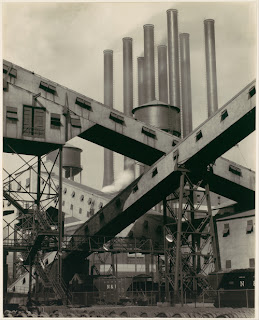 |
| Scheeler’s photo of Ford’s auto factory |
Although only separated by a levee from the Mississippi River, you would never know the swiftly flowing water was right next to you. It’s largely hidden from view, yet strangely connected to the land via large tubes crossing over the road. These link to the countless refineries and factories lining much of River Road, creating a foreign, but oddly interesting, landscape.
I remember traveling River Road at night and seeing the factories ablaze with lights–tiny towns functioning independently from others around them. There was an artist by the name of Charles Sheeler hired to photograph and paint similar factories and show off their inner beauty. Through his eyes, the maze of pipes became exquisite pieces of architecture. If you squint really hard and bury the innate feeling of driving “Cancer Alley,” you begin to see his perspective.
This is what I was contemplating when we came upon San Francisco Plantation, a lavishly ornate and boldly colorful mansion that inspired Francis Parkinson Keyes to write “Steamboat Gothic.” The house and grounds were amazingly pristine, yet out of place sandwiched beside another factory.
 |
| Godchaux-Reserve House |
We saw other plantations and extremely old homes sitting neglected and slowly melting back into the dirt and trees on the side of the road. There’s no telling how many of these structures have been lost to time, and by the looks of it, many of the ones we recently saw won’t be around for much longer. Some though, like the Godchaux-Reserve House–marked by the locomotive standing on its property–has been taken on by the community in an effort to preserve its structure and importance in history.
So finally arriving in Gramercy, we’re treated to expansive views of the river as we crossed high above its waters. The remainder of our drive south to Thibodaux was fairly uneventful, spent munching on popcorn from the local convenience station while we drove through open fields and torrential rain. As we entered Thibodaux, the flooding stopped as if a faucet had been turned off.
 |
| Wetlands Acadian Cultural Center in Thibodaux |
We drove the town, getting the lay of the land and counting the churches along Canal Boulevard. A sign for the Jean Lafitte National Historical Park directed us along Bayou Lafourche to the Wetlands Acadian Cultural Center. The kids sprinted through the exhibit area, showcasing the lives of the Cajuns, but then became engrossed in playing with the dozens of puppets and kid-sized palmetto hut in the kids’ “Gumbo Room.” Outside, a boardwalk overlooked scenic Bayou Lafourche.
Historic downtown Thibodaux is dominated by the Dansereau House Bed and Breakfast, the crown jewel of the city. The one-way streets through the city are lined with boutiques and restaurants, creating a vibrant yet intimate downtown.
We backtracked slightly out of town to eat at Boudreaux’s Restaurant, which came highly recommended by the Jean Lafitte park rangers. It was a good suggestion as we found plenty of tasty food to dine on, and the wait staff were very tolerable of two, umm, “active” children.
The route home took us along picturesque Highway 1, which parallels Bayou Lafourche, past Nicholls State College to Highway 90. We chose the quicker return route as the rain clouds rose high above us, threatening to let loose at any minute.
 |
| View of Bayou Lafourche |
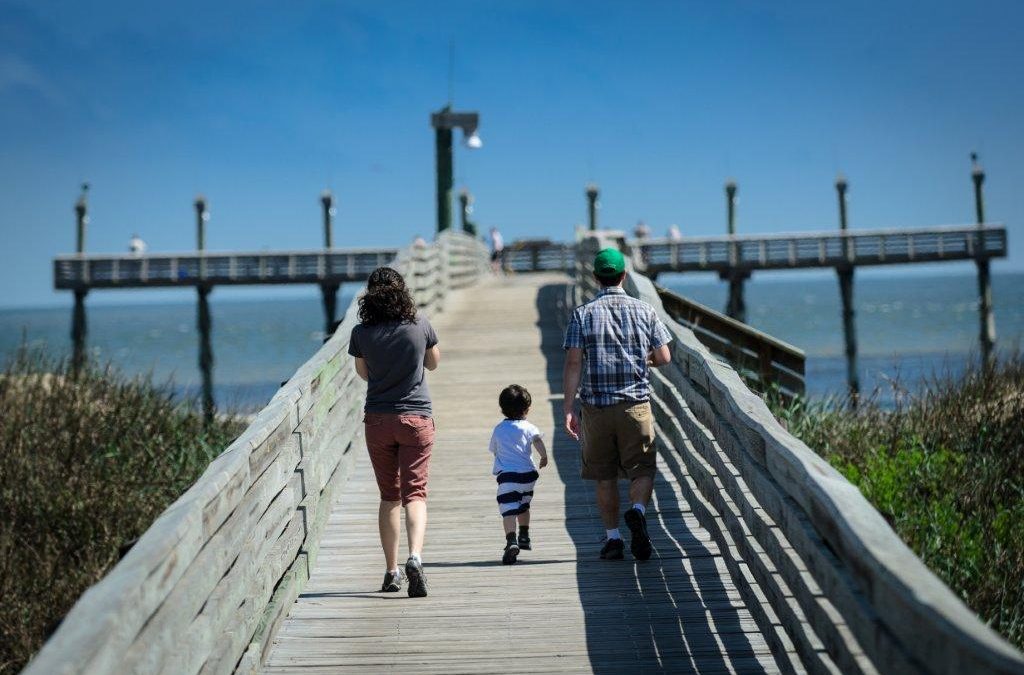
by admin | Mar 27, 2012 | Cajun Country
It’s amazing how much can change in a year. Last April, we visited Grand Isle for the annual Migratory Bird Festival, an event the whole island embraces as residents open their yards to birding enthusiasts. The island was bustling with activity, but some of the key attractions – such as the state park’s beaches – were closed due to tar balls lingering on the sand after the BP Oil Spill. Fast forward to 2012 and the sand is cleaner than ever and children were even playing in the ocean waters.
 |
| “Shrimp Boy” Charlie |
It’s a hefty drive for us – two and a half hours from New Orleans – so we scooted out of the house at 6:30 a.m. to make it in plenty of time for our 9:30 a.m. chartered fishing appointment. Poor August had to hang back with the grandparents, but Charles was giddy with thoughts of his day in the limelight. On the boat, our host Pat Bellanger took us to some of the best fishing spots around the island. It was exhilarating scaling the waves in the Gulf while porpoises played hide and seek around us.
Our guide offered us prime views of Fort Livingston, where Charles’ imagination was captured with thoughts of buried pirate treasure. I initially wondered if the trip might be too much for the four year old, but he reveled in being our “shrimp boy” – providing bait whenever needed – and gained a new best friend in the striped sheephead we reeled in. (I didn’t have the heart to tell him that the fish he was singing to “sleep” was soon going to be chopped up for our dinner.)
 |
| Pelican Rookery at Queen Bess Island |
Before heading back to dock, we were treated to a spin around Queen Bess Island, better known to the locals as Bird Island. It was here, amidst hundreds of nesting brown pelicans, that we caught site of hot pink wings flapping in the wind and I saw my first of many roseate spoonbills. These amazingly colorful birds did their best to hide within the recesses of the island, while the pelicans made a great showing of flying about, boldly flaunting their triumph over the oil that once threatened to destroy them and their habitat. It was a place I never knew existed, and its brilliance made me question what else I have missed seeing in the world.
Back on land, a voracious appetite had overtaken us, and we tried the poboys (our favorite traveling food) at the Starfish Restaurant. They loaded us up with seafood, and we left with full bellies and a renewed urge to see more of the island.
 |
| Grand Isle State Park |
The day was getting warmer when we entered Grand Isle State Park, and we tossed on some shorts and kicked off our shoes to take a walk. We made our way down the long stretch of sand toward the Gulf and dipped our feet in the lukewarm waters while Charles attempted to keep his beach ball from blowing away in the wind. A particularly strong gust sent the ball all the way back toward the grassy sand dunes, which turned out to be a stroke of good luck as it landed right beside a patch of moon snails waiting to be scooped up.
Feeling sun kissed, we next drove to the shady hiking trail maintained by the Nature Conservancy. Walking along the Lafitte Woods Nature Preserve, we scoped out the path that would soon be teeming with amateur and professional birders searching out the rarest migrating birds during the Migratory Bird Festival April 20-22.
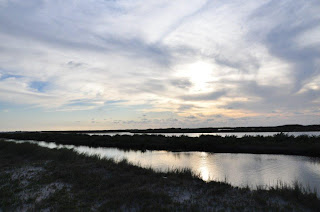 |
| View from Elmer’s Island Wildlife Refuge |
As the sun settled into the evening sky, we made one last stop on our way out at Elmer’s Island Wildlife Refuge. A long, bumpy road snakes through the marsh, taking you from Highway 1 to the sand-covered island. For those with four-wheel drive, you can take your car out onto the sand and park right up at the water’s edge. Even in a Jeep, though, we chose to play it safe and stop at the island’s entrance. We took one last leisurely walk, marveling at the man-of-wars washed up on shore, before snapping a few parting pictures of pelicans flying over the sunset.




























